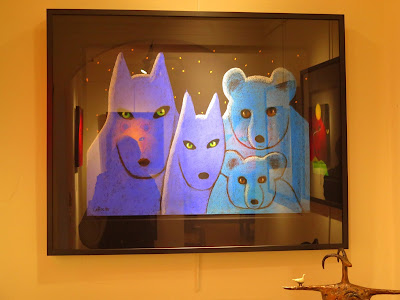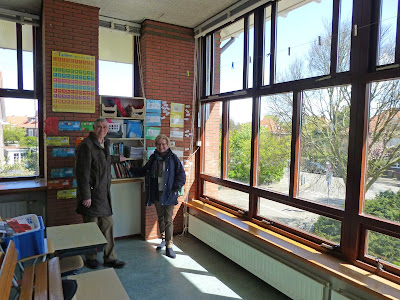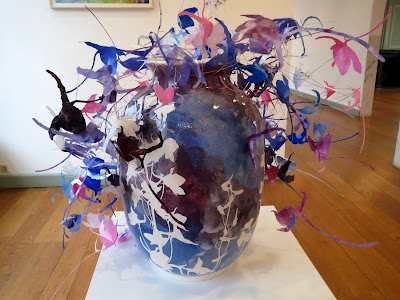When I was a small child, in the time parents did not ferry
their children to and from school, but they were shown the way and had to walk,
I walked for two hours every day. School was from 9-12 and from 2-4. As it was a
distance of 30 minutes for our still short legs, this meant we had one hour for
lunch at home. My father would cycle back from work to have lunch at home as
well. It was a time when there were so
few cars that we could count them, or at least the red cars we saw on our walk.
A group of children coming from different directions would meet in a square, and
from there we would walk together. Our route went through a very nice and leafy
residential area. Nevertheless, it could at times be boring, especially in
winter. But one of my fellow hikers, Jan Glas, was a very creative and
imaginative story teller who kept us spell bound by his tall stories. Of course
we believed them – and him. His father was the hero, who had fought with very
dangerous boa constrictors, lions and elephants in the bush. Our knowledge was
too limited to realise that some of those fear inspiring animals do not share
the same habitat. But his stories made our walk a lot shorter and far less
boring. Although later I learned that his father had never travelled abroad, the
stories were still magical and it did not spoil the fun.

I don't remember the play area in front of the school
The "new" school and the view from the classrooms towards the woods
The view seems the same after all those years
So I wasn’t surprised when some years ago I discovered that
Jan, whom I had completely lost touch with after primary school, had been writing
several novels of adventure. This time, they were more realistic and described
many aspects of his life and his hobbies. As a technician, a man of science, a man interested in the two world
wars which had raged through Europe, a man interested in aircraft and
everything to do with flying, as well as a keen mountaineer in his spare time,
he has written a series of novels with all those aspects in them. I learned he
was widowed and childless, which was similar to my own state in life. I too started
writing after being widowed. We shared the same past, the same primary schools,
and were class mates. So today we met as I was interested what started off his
writing and how he did/does it. We met in a restaurant in the dunes, battered
by sea winds, baked by the sun. After almost a whole lifetime there were so
many similarities, so many things which we both had gone through. We exchanged our own books, and after an exchange over lunch of
our past and past experiences, we drove off to one of our primary schools. It
was a school which was brand new when we became pupils, and such a relief after
our first school, the one which we walked to and which probably built up our physical
strength and our love of hiking. That first school was old and had dreary corridors and high windows
which prevented us from seeing much except the sky. The new school had very
wide windows, picture windows in fact, and the class rooms were sunny and
bright. Each class had its own small library at the back of the classroom and I
loved the serenity of the place, the light, the sun coming in through the windows.
In the first school I had felt a prisoner, in this new school I felt liberated.

The modernised playground between the school and the church at the back of the school. Quite an improvement on what is was when I was young.

Well, today we went back. The school has been extended, it
looks the same but is far more modern inside. A wing has been added to it, there
is now a library, there are rooms where one can relax in nice chairs and cosy
corners, and all the school boards are digital to mention just a few changes.
We met the caretaker as the school was being redecorated during the two week spring
holiday, and thus open. The caretaker, a former pupil as well, was interested
in our story and allowed us to go inside and look around at leisure. He was our
guide, but also left us to explore things on our own. The view from the school
and my former classrooms was still the same. In fact, a kind of peace filled
me. The sun was out, although it was a very cold spring day. But the houses
were the same and looked so familiar. I had lived in this area and in the next
street for so many years. The windows of the school still had this attractive
view. A view of budding and flowering trees, of wide streets with little traffic,
of big front gardens and houses sheltering under red tiled roofs.

Some more pictures taken by the caretaker of the school, also a former pupil
Jan Glas and I, former classmates
Behind the school was the church which our parents were so proud
to have been able to finance with all the other members of the congregation. At
that time, in 1954, it seemed quite luxurious and spacious. It had a basement with
a kitchen and rooms for meetings, parties and other functions. After having our
church services in the gym hall of an old primary school, at last we had our
own church with a custom built, modern pipe organ! Fortunately the church is
still there, although much closer to the school than I remember. It now belongs
to another church denomination, but at least it is still used as a church. It
looked simple, with the original wooden pews, but still functional, clean and modern. Before the church was
built, I had an allotment there. They were school allotments, where we learned
to sow and harvest potatoes, watercress and carrots, as well as flowers.

A for us new area in the school where pupils can "chill".
Not much seemed changed since the school and the church were
built, quite remarkable in an area where change is the order of the day.
We said goodbye, wishing that we could meet with more of our
former fellow pupils, if still among the living. But we also realised some no
longer were, and even quite a few had emigrated to the USA and Canada.
1954-1955, Willem de Zwijgerschool
I am sitting next to the window and the central heating at the front desk with the round face and the straight hair, Jan is sitting left at the front desk in the second row, wearing a striped sweater.























































